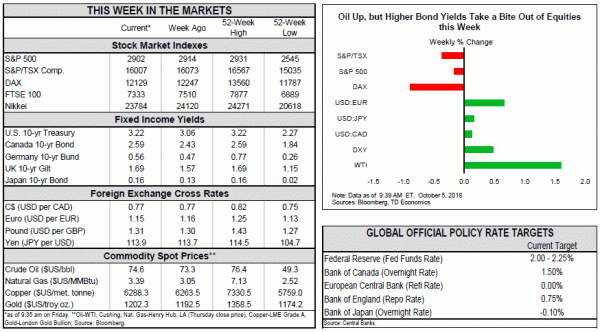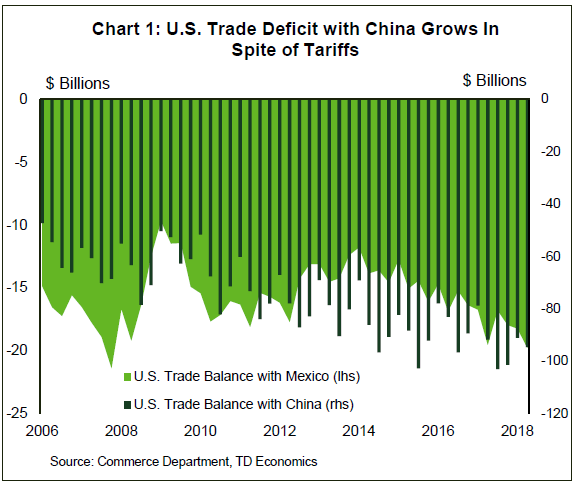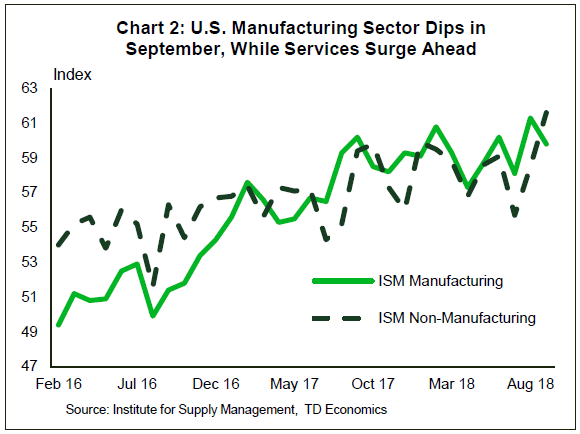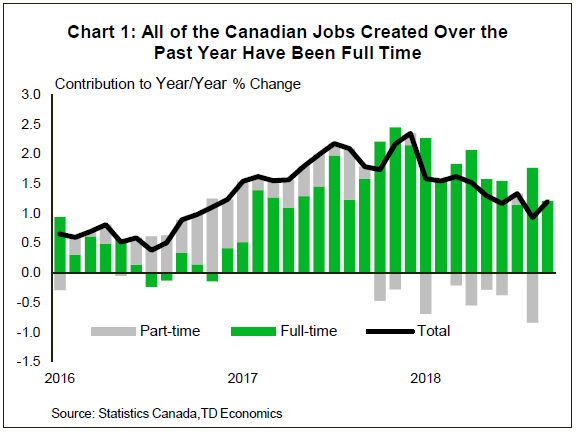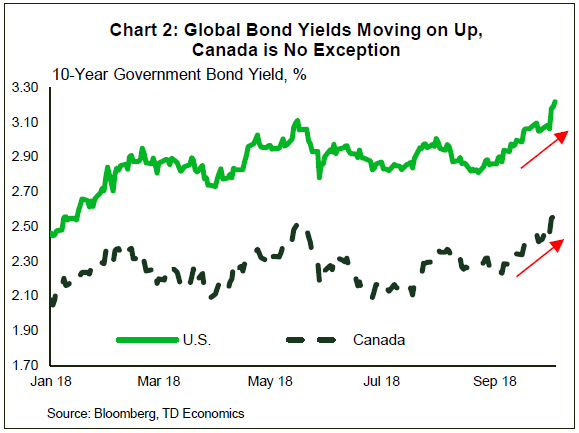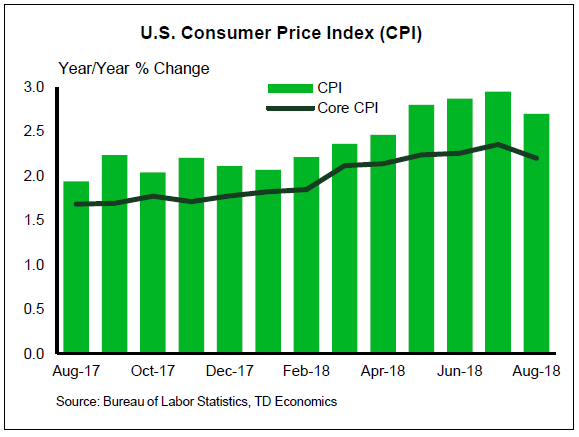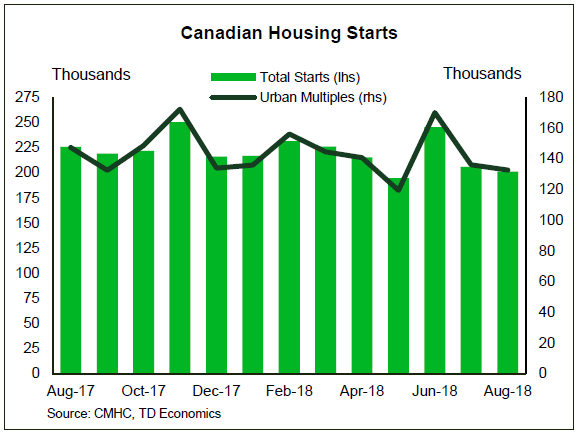U.S. Highlights
- The big story of the week is the trade deal struck just in the nick of time between U.S. and Canada. The new USMCA deal will see Canada joining the agreement previously worked out between the U.S. and its southern neighbor and calms some fears, particularly among auto manufactures in the region.
- Overall manufacturing activity, though still hot, dialed back the temperature a bit in September. The services sector however, continued to increase the heat, coming in at an all-time high with price pressures edging up.
- The 134K gain in U.S. employment was less than expected, but the unemployment rate is at a near 50 year low, pushing bond yields up after its release.
Canadian Highlights
- It was a big week for Canadian newsmakers. After signing onto a new trade deal, Prime Minister Trudeau was in Vancouver announcing a $40 billion investment from LNG Canada in Kitimat British Columbia.
- Canadian economic data was mixed. The labour market added 63k jobs, but full-time employment fell and so did aggregate hours. Wage growth also decelerated.
- The rout in global bond markets extended to Canada, with yields rising across the curve. The Canadian 10-year yield hit its highest level in over four years.
U.S. – New NAFTA Cools Trade Tensions
The week started off with the good news that the U.S., Mexico and Canada had reached a last-minute deal for a successor to the tri-country NAFTA pact. The U.S.-Mexico-Canada Agreement (USMCA) marks a new era for trade among the three countries. It also means the U.S. will no longer be fighting a trade war on multiple fronts. The trade brawl is now primarily between the U.S. and China, with no clear end in sight.
The White House is determined to rewrite trade flows, and has not been shy in using tariffs to this end. While their deficit with Canada has been declining, their deficit with Mexico is nearing historic highs, and that with China has worsened despite tariff measures (Chart 1). It remains to be seen if the latest tranche of tariffs imposed on China are up to the task of “correcting” this perceived imbalance and how it will impact growth (see paper).
There are still vital steps ahead for USMCA implementation, but the agreement in principle allows auto manufacturers in all three countries to breathe a sigh of relief. The deal, however, may raise U.S. vehicle prices in the future given new provisions on wages for auto workers.
For the manufacturing sector as a whole, activity dipped slightly in September, but remained at healthy levels. In particular, the decline in new orders backlogs and supplier delivery times suggests that output at manufacturing firms is catching up with demand – a development which should keep the lid on latent price pressures. Even better was the ISM non-manufacturing index which reached an all-time high in September with all sub-indices and sectors either growing or remaining constant m/m (Chart 2). Unlike their manufacturing counterpart though, service firms appear to have a harder time meeting demand, resulting in prices edging up. Overall, both sectors indicate that the U.S. economy is still at the top of its game, even while capacity constraints and rising tariffs pose a challenge.
Various Fed speakers did the rounds this week, talking up the current strength of the US economy. On Tuesday, Fed Chair Powell hailed a “remarkably positive outlook” for the economy. He characterized the combination of steady, low inflation, and very low unemployment as ”extraordinary times” and noted that the U.S. is on the verge of a “historically rare” era.
The jobs report was the icing on the cake. While the addition to nonfarm payrolls came in lower than expected (134k vs. 188k), employment levels remain elevated. With employers struggling to find people to fill positions, and the impact of hurricanes, the slowdown in hiring isn’t all that surprising. The unemployment rate, however, continues to impress, falling to a near half-century low of 3.7%. In response, 10-yr Treasury yields breeched 7-yr highs (above 3.2%) – cementing increases posted earlier in the week on similarly strong ADP employment data. All in all, the U.S. economy remains a force to be reckoned with and poised for above 3% growth in Q3.
Canada – Its A Relief to have the US-M-C-A!
What a week. In under seven days we have had an updated NAFTA (the newly minted USMCA), a major investment announcement in LNG in British Columbia, an update on the Canadian labour market, and just top it off, a rout in the bond market.
The new USMCA is a big deal (literally, at hundreds of pages). For Canada, the agreement brings a sigh of relief, reducing a major source of uncertainty and maintaining access to the North American market that is the source of nearly three quarters of Canadian exports. To get there Canada had to make some concessions, agreeing to allow American dairy producers to access 3.6% of the Canadian market and accepting longer patent protection on prescription drugs. The de-minimis threshold – how much Canadian consumers can purchase from the U.S. without paying duty –was also raised to $150 (from $20). Good news, at least, for cross border and online shoppers.
Canada also accepted quotas on auto exports, but at levels well above current production and which only apply to vehicles that do not meet the minimum North American content rules. This implies basically the status quo for the Canadian auto sector. Just as important as the trade deal itself was the side agreement that guaranteed the U.S. would not impose tariffs on Canadian autos under national security provisions (section 232).
Relative to maintaining the original agreement, the trade deal is unlikely to do very much to raise Canadian growth prospects. However, without a deal, Canada’s economy would grow noticeably slower. The Bank of Canada estimated that absent a deal, the Canadian economy would have been about 0.5% smaller by the end of 2020.
With a deal removing this source of downside risk, the Bank of Canada can focus on the economic data. On the surface it was a pretty good week. The Canadian economy generated an estimated 63k jobs in September and the Canadian trade balance moved into surplus territory. Unfortunately, the details of both reports were less sanguine. All of the jobs created (+80k) were part-time, while full-time jobs pulled back 17k. Wage growth of permanent workers decelerated to 2.2% in the month. On the trade side, the move to surplus reflected a pullback in both imports (-2.5%) and exports (-1.1%). All told, the economic data were mixed, providing little signal in either direction.
Equally important to the Bank of Canada may be the recent move in the bond markets. Post-USMCA optimism has led investors to expect stronger growth and more rate hikes, leading to a broad-based sell off in global bond markets. In Canada, the sell off this week was concentrated more at the long-end of the curve, with the 10-year yield up over 15 basis points to sit just below 2.6% (as of writing). Despite an alleviation of trade risks, domestic risks – namely high household debt levels – may still pose a limiting factor on the pace of future Bank of Canada hikes.
U.S.: Upcoming Key Economic Releases
U.S. Consumer Price Index – September
Release Date: October 11, 2018
Previous: 0.2% m/m; core 0.1% m/m
TD Forecast: 0.2% m/m; core 0.2% m/m
Consensus: 0.2% m/m; core 0.2% m/m
We expect CPI to slip to 2.4% on a moderation in gasoline prices, partially offset by a pickup in core CPI. We expect the latter to post a 0.2% m/m rise (2.3% y/y) on a rebound in apparel and medical services, both of which drove the downside in August. Together with a strong read for shelter, these components should limit any downside this month. Food prices also have scope for a pickup after months of weakness.
Canada: Upcoming Key Economic Releases
Canadian Housing Starts – September
Release Date: October 9, 2018
Previous: 201k
TD Forecast: 225k
Consensus: N/A
Housing starts are forecast to recover to a 225k pace in September on a rebound in multi-unit starts, although we see scope for another slowdown in single family construction. Single family starts are sitting just 0.15k (annualized) above post-crisis lows but permit issuance continues to trend lower amid an affordability crunch in major population centers. This has helped support demand for condominiums, which developers have tried to meet with a flood of new supply since 2017. Permit issuance for multi-unit projects saw a sharp decline in June but has started to come back since, which supports a stronger pace of starts for September.




